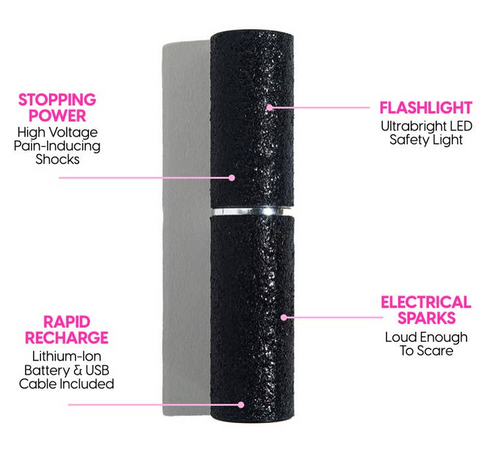Have you ever wondered how powerful a stun gun really is? Many folks think about safety and self-defense at home. A stun gun could be part of your plan. One thing that gets people curious is how many volts a stun gun has.
Stun guns are not toys. They are tools to help keep you safe by stopping an attacker.
Stun guns work by using electricity. This shocks the person who gets too close without hurting them for life. Our blog will tell you all about the volts in a stun gun, from the usual amount to what the law says is too much.
We'll keep it simple and straight to the point, making sure you get just what you need to know.
Table of Contents
Key Takeaways
- Stun guns can have volts ranging from 50,000 to 1,000,000. The higher the voltage, the more powerful the stun gun.
- Voltage alone does not decide how strong a shock you get. Skin moisture and abrasions can change how much it hurts.
- In the United States, there's no nationwide rule for stun gun voltage. Each state decides its own limits.
- In many places outside of the U.S., like Canada and Europe, owning a stun gun is illegal without special permission.
- The true power of a stun gun also depends on amps and watts, not just volts. It is the high amps that can kill; high voltage (such as those in stun guns) only hurt by causing muscular spasms and temporarily incapacitate.
Exploring Stun Gun Voltage
In the exploration of stun gun voltage, we delve into the potency of these devices. We will consider the typical voltage range and legal boundaries, maintaining straightforward yet enlightening information.
Typical Voltage Range of Stun Guns

Stun guns deliver a high-voltage shock. Examining their power, the range is broad. Commonly, they vary from 50,000 volts to a dramatic 1,000,000 volts. The variety is due to differing necessities. Some individuals prefer additional security, while different scenarios may call for more potent tools for professional purposes. To clarify, here is a straightforward table that outlines these powerful devices:
|
Voltage Range |
Common Use |
|
50,000 - 250,000 volts |
Personal safety for everyday people |
|
250,000 - 500,000 volts |
Increased security needs |
|
500,000 - 1,000,000 volts |
Professional security and law enforcement |
It's essential to understand that voltage alone doesn't determine impact. The reaction of the target also depends on several factors. Variables such as the moisture level of the skin or abrasions can reduce resistance, intensifying the shock. Resistance naturally differs with voltage levels.
For example, at a lower voltage like 100V, resistance might be quite substantial, about 1,200 Ω to 3,200 Ω. In contrast, resistance tends to decrease at higher voltages, such as 1,000V, to a range of 700 Ω to 1,500 Ω.
Hence, despite the impressive figures, what's crucial is the method by which the stun gun applies this power. The discussion will continue with the highest legal voltage limits for stun guns to balance safety and the need for effective defense tools.
Maximum Legal Voltage Limits for Stun Guns

Blingsting's Lipstick Stun Gun
Discussing the power behind stun guns, here are the legal constraints. Different locations have varied regulations. Consider these essential points:
|
Country/Area |
Maximum Legal Voltage |
|
United States |
Varies by state, no federal limit |
|
Canada |
Illegal to own without a license |
|
Europe |
Illegal in many countries |
|
Australia |
Illegal to own without a valid reason |
The table indicates that regulations depend on location. In the U.S., the focus is on individual state laws due to the absence of a national standard. In contrast, nations like Canada and Europe enforce more prohibitive laws. Now, examine the mechanism of stun guns.
Conclusion
Stun guns possess considerable power. They typically feature volts in the thousands, yet the significance isn't limited to high voltage alone. There are regulations in each state dictating the permissible strength of these devices.
This highlights the essentiality of comprehending volts, amps, and watts—particularly when considering self-defense tools like stun guns or Tasers. Hence, contemplate your safety needs and ensure they comply with the laws of your residence.
FAQs
1. What is the voltage of a stun gun?
Stun guns can vary in voltage, but they typically have high voltage to create a significant electric field strength. However, it's important to note that while the voltage may be high, the amperage or current is usually low.
2. How does a stun gun work?
A stun gun works by using batteries to power an oscillator circuitry which boosts the voltage and decreases the amperage. The electricity then travels across two electrodes creating an arcing electric field that disrupts electrical components within a target.
3. Is high voltage lethal?
High volts alone won't cause harm; what's lethal is a combination of high volts and amps - this explains why tasers are non-lethal despite their high voltage. They have limited amperage making them safe for home security use.
4. Does anything affect how well a stun gun works?
Yes! Factors such as dielectric breakdown or resistive material between electrodes (like clothing) can impact effectiveness due to increased electrical resistance or reduced conductivity.
5. Are there other uses for stun guns besides self-defense?
While primarily used as non-lethal home security tools, some models come with additional features like flashlights or alarms providing more value beyond personal protection.

